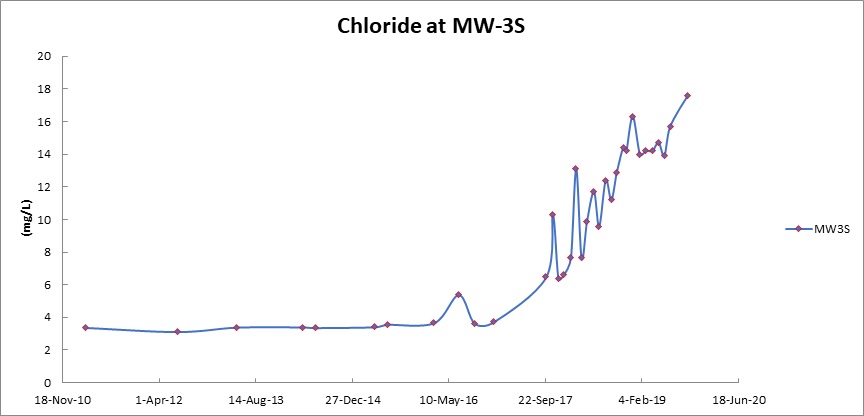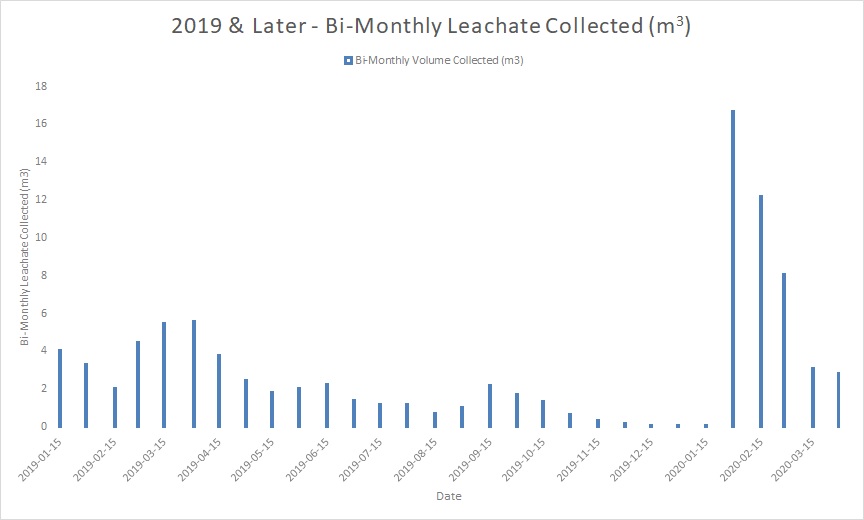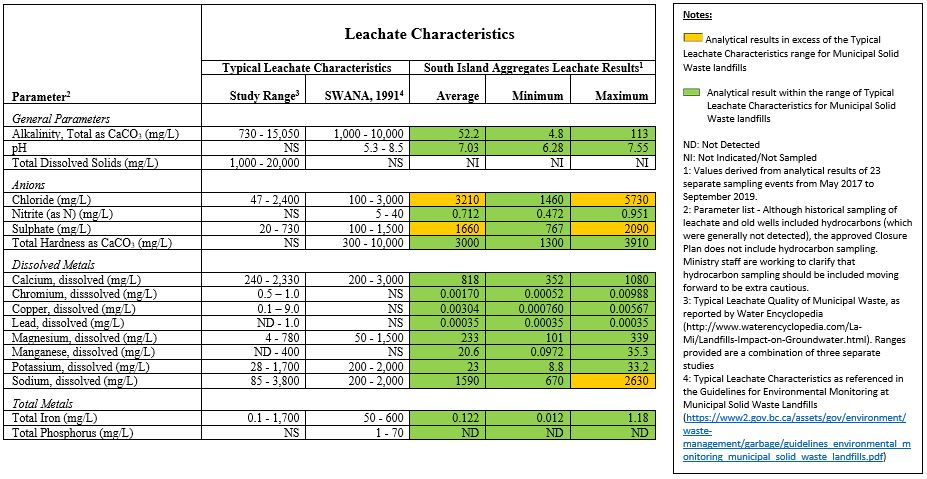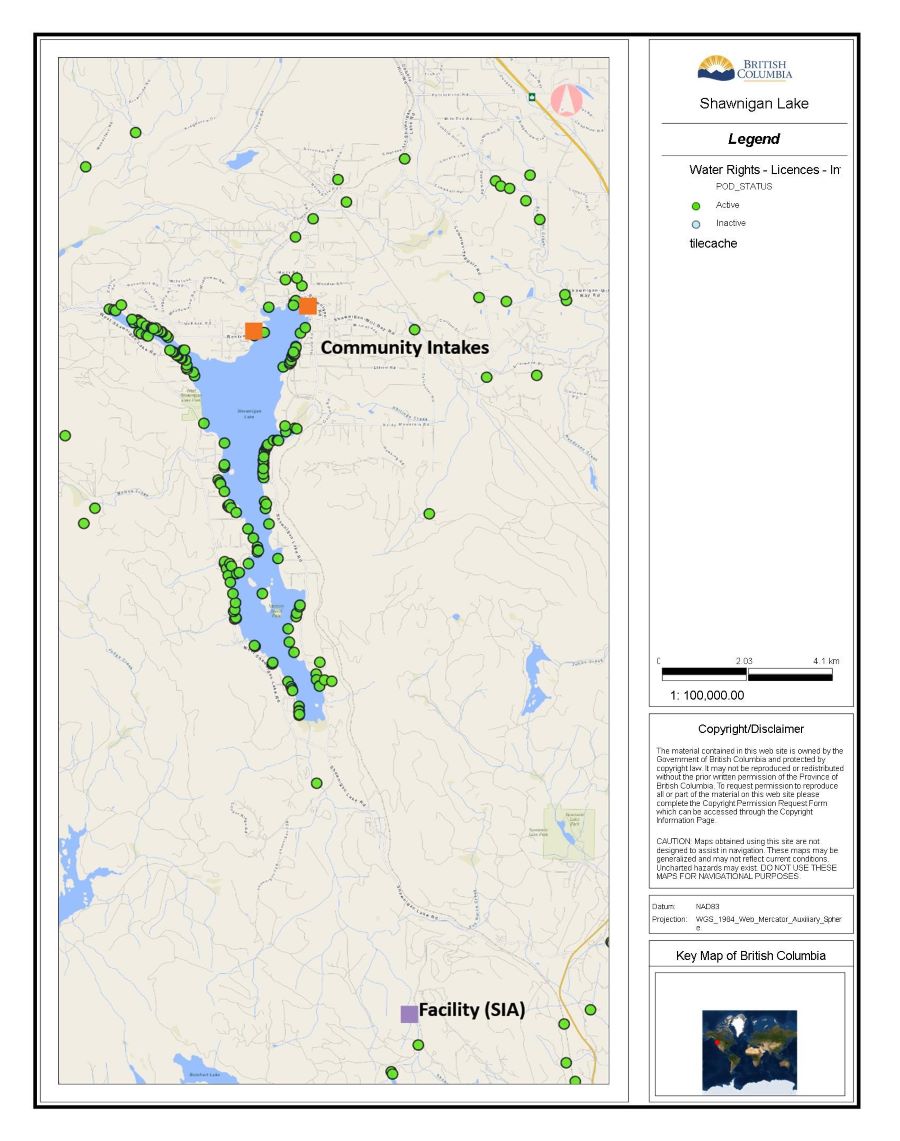SIA / CHH Landfill - Frequently Asked Questions
Below is a list of questions recently received from the community, along with responses from the ministry. An earlier version of Frequently Asked Questions (PDF) from April 2019 is also available.
Closure and Post Closure Environmental Monitoring Program (EMP)
What are the current environmental monitoring requirements in place at the site?
The ministry has recently provided detailed feedback to the Named Parties regarding the Environmental Monitoring Program (EMP). The EMP is expected to include:
- Monitoring leachate quality and volume, measuring water levels in groundwater monitoring wells (MW-01S/D, MW-01, MW-3S/D, MW-5S/D, MW-06, MW19-01, and MW19-02) and seepage blanket wells (SB-1, SB-2, SB-3 and SB-4), and analyzing water quality in groundwater monitoring wells (MW-3S, MW19-01 and MW19-02), seepage blanket wells (SB-1, SB-2, SB-3 and SB-4) and at a surface water monitoring location (SW-1). Leachate is to be sampled before treatment and disposal off-site. Measuring water levels in the wells is to occur four times a year. Water from the groundwater monitoring wells and seepage blanket wells is to be sampled four times per year. Surface water is to be sampled monthly during closure activities and for a minimum of 12 consecutive months following the completion of closure activities. Thereafter, surface water will be sampled quarterly.
- Regular post-closure inspections of the landfill, final cover, leachate storage works, and environmental monitoring works.
- Adjustments to the EMP over time, in response to data.
- Contingency Actions including a Trigger Response Plan.
Groundwater Monitoring Program
Why were the new wells drilled?
Most of the original monitoring wells at the site are very deep and recent ministry review of the old monitoring program and data revealed that these wells on their own may not provide early indications of groundwater quality changes. To improve the monitoring network, two new shallow monitoring wells (MW19-01 and MW19-02) were installed in Fall 2019 directly downslope from the landfill. Along with the seepage blanket wells, the new shallow wells should provide early detection of leachate migration in groundwater. The new wells were first sampled in December 2019.
What are the sampling results from the new monitoring wells?
The sampling results for the new shallow groundwater monitoring wells (MW19-01 and MW19-02) including laboratory data, and ministry memos that summarize and interpret the results, are posted on the Ministry website.
Why has the EMP changed since the approval of the Closure Plan?
The ministry continuously reviews EMP data submitted by the Named Parties. These reviews, combined with recommendations from the Named Parties’ Qualified Professionals (QPs), resulted in adjustments and improvements to the EMP. As mentioned above, the ministry has recently provided detailed feedback to the Named Parties regarding the EMP.
The EMP is subject to ongoing changes and improvements based on monitoring results and triggers informed by an evaluation of the full dataset, including benchmarking against water quality standards, baseline background data (if available), and interpretation of trend analysis and other analysis including geochemical analysis using Piper diagrams. Adjustments to the EMP help ministry staff ensure that any leachate leaving the landfill is detected early throughout landfill closure and post-closure.
The EMP also includes Contingency Actions contained in a Trigger-Response Plan. The Trigger Response Plan can be summarized in the following five steps:
- Routine water monitoring and reporting (as summarized above);
- Confirmatory monitoring in the event that water quality changes occur;
- Additional investigations to identify the source of those changes and determine whether environmental impacts are occurring;
- Mitigation strategies to remedy the source, if deemed necessary, based on the preceding; and
- Follow-up monitoring to evaluate the efficacy of the mitigation strategies.
Why are hydrocarbons no longer being tested in the wells?
The testing for hydrocarbons in the monitoring wells was temporarily discontinued because the 2019 Updated Final Closure Plan indicated that:
- hydrocarbon levels in leachate and groundwater were generally low,
- the inconsistent hydrocarbon detections in groundwater wells may be due to natural sources or mining activity, and
- some cases of hydrocarbon detection pre-date landfill operations and therefore cannot be from the landfill.
However, the ministry has recently provided detailed feedback to the Named Parties regarding the EMP, and it is expected that the EMP will include hydrocarbon sampling and investigation.
What is being done about the increasing trend in chloride at MW-3S?
Although chloride levels were increasing slightly, they remain well below (one whole order of magnitude below) the most conservative water quality guidelines of 250 mg/L of chloride, and therefore are not a concern for aquatic life or drinking water. See below for the chloride levels trend since 2010.
The ministry has recently provided detailed feedback to the Named Parties regarding the EMP, and it is expected that the EMP will include a continued sampling of MW-3S to monitor chlorine levels into the future.
Chloride Trend at MW-3S. The most conservative water quality guideline for chloride in groundwater is 250mg/L.1
[1] Contaminated Sites Regulation, Schedule 3.2 Generic Numerical Water Standards.
Landfill Leachate Management
How much leachate is being generated by the landfill right now and is this normal?
All landfills generate leachate, and the amount of leachate any individual landfill generates depends on a variety of site-specific factors including precipitation, the landfill’s engineering and the composition of the waste. The volume of leachate being generated at this landfill must be reported by the Named Parties twice per month in the status reports posted on the Ministry website. In addition to reporting the volumes, the leachate must be collected, stored in on-site leachate storage tanks, and transported to an off-site authorized treatment/disposal facility.
Up until the January 15, 2020 status report, the leachate volumes showed a normal general decreasing trend, as predicted by QPs. However, the January 30 status report showed an abnormal increase in leachate volume collected (see the graph below, 2019 & Later Bi-Monthly Leachate Collected). This is further discussed below in a subsequent response.
2019 & Later – Bi-Monthly Leachate Volume Collected (m3)
What happened in the January 30 status report which showed an abnormal increase in leachate generation?
Ministry staff closely review monitoring data, including leachate volumes, as it is reported. After reviewing the January 15 status report, the ministry requested that the Named Parties examine the leachate collection system. The investigation by the Named Parties revealed that the leachate valve on the pipe that conveys leachate to the leachate storage tanks was partially closed. This may have caused very low leachate volumes to enter the leachate storage tanks from late 2019 to early 2020. After the valve was fully opened in late January, it is hypothesized that the accumulated leachate contained in the lined landfill flowed through the pipe and entered the leachate storage tanks resulting in the abnormal increase in leachate volume reported in the January 30 status report. The status reports for February 15 and 28, and March 15 and 30 show that the normal decreasing trend for leachate volume has resumed (see the graph, 2019 & Later Bi-Monthly Leachate Collected in the previous response).
See the Ministry memo dated February 24, 2020, posted in the Spill Prevention order Information M01701 section below, for more information on this topic.
How does the quality of leachate from this landfill compare with other landfills?
The composition of a landfill’s leachate is dependent on various site-specific factors including the type and age of waste, the climate and moisture regime of the area, and the geology and hydrogeology of the site. As such, comparing leachate quality between different landfills can be misleading. That said, a range of parameters comprising leachate quality for landfills is documented in the literature.
Table 1 offers a comparison between the SIA landfill’s leachate quality and typical leachate characteristics. These comparisons suggest that the leachate generated from the SIA landfill is generally in line with typical leachate characteristics. Exceptions include chloride, sodium and sulphate readings, which exceed the typical range. This is expected because the landfill received marine sediments and stabilized sulphur-rich soils from a sulphur terminal (Pacific Coast Terminals – see April 2019 FAQ, Q25 & 26) which would naturally contain high concentrations of those parameters.
Table 1: Comparisons of SIA Leachate to Typical Leachate Characteristics
Table 1 shows leachate sampling results as derived from the analytical results of 23 separate sampling events from May 2017 to September 2019. These comparisons indicate that the leachate generated from the SIA landfill is generally in line with typical leachate characteristics except for chloride, sodium and sulphate, which exceed the typical range. This is not unexpected because the landfill received marine sediments which would naturally contain high concentrations of those parameters.
Why are some leachate parameters like Chloride, Sulphate and Sodium showing up in elevated concentrations? Do these pose a risk?
Levels of chloride, sulphate and sodium are understandable given the source of soil landfilled, as discussed above. The leachate does not pose a risk because it is collected, stored in on-site leachate storage tanks, and transported to an off-site authorized treatment/disposal facility.
Site Surface Water Management
With all the truck traffic on-site, why aren’t trucks required to wash their wheels before leaving the site?
The Spill Prevention Order (SPO) does not specify requirements for a wheel wash station because contaminated soil is not being brought onto the site, and the truck wheels do not contact the contaminated soil that is encapsulated in the landfill. The previous permit (105809) required a wheel wash station because there was a reasonable possibility that wheels from trucks carrying and dumping contaminated soil could contact contaminated soil while landfilling contaminated soil. The soil that is now being brought onto this property as part of implementing the Updated Final Closure Plan must meet industrial land use standards and is of the same or better quality as soil that is allowed to be transported and deposited on any industrially-used site in B.C. (i.e. it is not contaminated).
What requirements are in place to protect the surrounding environment from stormwater runoff?
Mines Act Permit requirements are in place requiring surface water runoff to be routed to a settling pond (or through other erosion control infrastructure) before leaving the site. Although the Ministry of Environment and Climate Change Strategy does not actively regulate surface water runoff in rock quarries, there are general provisions in the Environmental Management Act that prohibit pollution. The Updated Final Closure Plan for the landfill also identifies measures to be taken to minimize any risks associated with the runoff of water that has not come into contact with contaminated soil (all contaminated soil is fully encapsulated in the lined landfill).
Since the importation of soil for the wedge began on December 23, 2019, staff from the Ministry of Environment and Climate Change Strategy and the Ministry of Energy, Mines and Petroleum Resources have been visiting the site regularly to ensure that activities are being conducted in accordance with prescribed requirements and in a manner that does not pose a risk to the nearby environment. Observations made on-site by ministry staff and QPs do not indicate any concern. Ministry staff are conducting daily site visits when closure activities are occurring, to make sure that requirements imposed on the Named Parties are met and that closure is proceeding as per the approved Updated Final Closure Plan and conditions set by the ministry.
Drinking Water Resources
Are drinking water sources downstream of the SIA site at risk?
The SIA site is located about 5 km south of Shawnigan Lake and about 11.5 km south of the two community water intakes at the north end of Shawnigan Lake. There are many active domestic water licences on the lake, and the closest licence is about 200 m from the South Shawnigan Creek (SSC) inflow to the lake (see the map below). The two community water intakes are at the north end of the lake approximately 6.5 km from the mouth of SSC. Shawnigan Lake and SSC are not “designated community watersheds” under the Forests and Range Practices Act.
In 2007, Water Quality Objectives (WQO) for Shawnigan Lake was developed to protect existing and future water uses including drinking water. These objectives include nutrients, bacteria, turbidity and conventional lake parameters.
The monitoring efforts to date, conducted by various parties including the Cowichan Valley Regional District (CVRD), the ministry and the site owners and operators, have shown there is no impact from SIA on the surface water in either the SSC or Shawnigan Lake, and water and sediment quality are generally good.
Some tributaries to Shawnigan Lake, including the SSC, have elevated phosphorus and high summer temperatures not associated with SIA. Van Horne Creek, an SSC tributary that enters the SSC downstream of SIA, has shown elevated iron and arsenic. Roads and an inactive recycling depot are potential sources of metals near the sampling site. The sediment at Van Horne Creek has also had elevated metals and hydrocarbons. No other issues in the SSC have been identified.
Higher bacteria levels (including from humans and domesticated animals) were found in tributaries at the north end of the lake.
Shawnigan Lake Water Quality Objective attainment monitoring has been conducted for over a decade including in 2018 and 2019. While the overall water quality is good, the largest concern for drinking water quality in Shawnigan Lake is nutrient enrichment which can and does result in algal blooms during the summer and fall. Algal blooms cause taste and odour issues and have the potential for toxins which can be harmful to humans, domestic pets and wildlife. Nutrients can be attributed to residential run-off, septic systems, agricultural activities and land disturbances, but not the SIA landfill.
There is no discernable link or relationship from SIA activities on Shawnigan Lake drinking water quality. The water quality for Shawnigan Lake and South Shawnigan Creek is good.
Shawnigan Lake Area and Water Rights
How can you be sure that the soil being imported for the wedge isn’t going to contaminate downstream drinking water or groundwater?
The soil being imported to construct the stabilizing soil wedge must meet industrial land use standards. As such, the soil must meet the same standards applied to any industrially-used site in the province. Before the soil can be brought to the site, a Statement of Assurance confirming that the soil meets these standards must be submitted by a QP who is a member of the Contaminated Sites Approved Professionals List.
Two such statements, one for each source site, have been provided as of mid-April 2020. The first was provided on December 18, 2019, for soil originating from 3100 Constellation Avenue. 3100 Constellation Avenue has historically been an undeveloped forested area. Because the source site is undeveloped, it is highly unlikely that the imported soil will contaminate downstream drinking water or groundwater. The second statement was provided on March 31, 2020, for soil originating from 765 Willing Drive. 765 Willing Drive is a residential lot in a predominately residential area. Prior to the construction of the residence in 1975, the area was vacant forested land. A Stage 1 Preliminary Site Investigation was completed for the lot and no areas of potential environmental concern or potential contaminants of concern were identified. As such, it is again highly unlikely that soil imported from this site will contaminate downstream drinking water or groundwater. Similar Statements of Assurance will be required for future soil sources prior to being imported.
In addition to the Statements of Assurance provided by the Named Parties’ QPs, the EMP is expected to include a monthly sampling of the surface water site, SW-1, during closure activities and for a minimum of 12 consecutive months following the completion of closure activities. The sampling of SW-1 will serve to monitor if there are any water quality impacts due to the installation of the stabilizing soil wedge
How can you be certain this landfill won’t impact our drinking water?
To prevent leachate from entering the environment, the landfill bottom is lined with an upper geomembrane liner and a lower clay liner of approximately 1-metre thickness. Leachate is collected and stored in on-site leachate storage tanks and, as necessary, transported to an off-site authorized treatment/disposal facility. To prevent precipitation from infiltrating into the landfill and creating more leachate, the landfill top is covered with a geomembrane, and will also be covered with cover soil. To verify that leachate is not impacting groundwater, surface water or drinking water, a comprehensive EMP is being implemented including monitoring of leachate, groundwater, and surface water. Regular inspections of the landfill and associated works are and will continue to be conducted and contingency actions including a Trigger Response Plan are required to be in place. The EMP and results will be prepared and reviewed by QPs and ministry staff and will be carried out for a post-closure period which is expected to be no fewer than 30 years. Finally, if necessary, the ministry can impose additional requirements pursuant to the Environmental Management Act and/or the Spill Prevention Order.
Ministry Oversight
How is the ministry monitoring the work of the Named Parties to ensure they are fully and properly implementing the closure plan?
The ministry is staying apprised of site activities through QP involvement and staff oversight. QPs engaged to perform specific closure plan work must be approved by the ministry. A QP is required to be continuously present on-site to supervise all closure activities. In addition to QP involvement, ministry staff are conducting daily site visits when closure activities are occurring, documenting ongoing activities and reviewing submitted reports. Combined, these oversight actions allow the ministry’s Compliance Team to conduct thorough compliance inspections to confirm whether the Named Parties are in compliance with the Spill Prevention Order (SPO) and the Updated Final Closure Plan. Any non-compliances are taken seriously and addressed as appropriate using the ministry’s Compliance and Enforcement Policy and Procedures.
Why were the Named Parties granted an extension for completion of closure?
The Named Parties requested an extension to August 31, 2020, to complete the construction activities for implementation of the Updated Final Closure Plan. This was due to the availability of common fill material, subcontractor schedules and to avoid winter weather conditions that are not favourable for placing and compacting fill material and could affect the quality of construction work. On October 18, 2019, the Minister approved an alternate date of August 31, 2020, for the completion of construction activities for implementation of the Updated Final Closure Plan. In approving the extension, he placed additional conditions for the protection of the environment including a comprehensive pre-winter inspection of the landfill. New deadlines were also added to five of the pre-existing conditions to ensure the project moves forward in a timely and safe manner, including the requirement to drill two more monitoring wells within 30 days.
Why hasn’t the Minister ordered the removal of the soil from the site?
To date, there is no indication that the environment or human health is at risk as a result of the landfill. Therefore, it is beyond the scope of authority given to the ministry in legislation to order the removal of the soil.
Implementation of the 2019 Updated Final Closure Plan with reasonable additional conditions provides sufficient protection to prevent or reduce the risk of an escape or spill of contaminating substances from the landfill to the environment.
Ministry staff conducted a detailed technical review of the 2019 Updated Final Closure Plan. The review involved ministry staff, including engineers and a hydrogeologist, with significant input from an independent third-party consulting firm (GHD) on landfill engineering, geotechnical and hydrology aspects. The review also considered input from Ministry of Energy, Mines and Petroleum Resources, the ministry’s Land Remediation Branch, the local community and previous advice from two independent QPs contracted to support the ministry in 2017 (Hemmera and GHD).
This question is further addressed under the heading “Soil removal” on page 7 of the document “Reasons for Decision Conditional Approval of 2019 Final Closure Plan for Cobble Hill Holdings Landfill”, dated June 26, 2019. This document is on the Ministry website.
Given that the property has been forfeited to the Crown, how does this affect the Spill Prevention Order and the closure plan?
The Spill Prevention Order for the site remains in place, whether taxes are paid or not, and regardless of who owns the land. Forfeiture of the property does not impact the closure plan or EMP. The Named Parties remain responsible for implementing the closure plan.
How can the ministry and the community be assured that the Qualified Professionals (QPs) working on this project are not biased in conducting their work since they are being paid by the company?
In the past year, the government has introduced new legislation and has been working towards improved governance systems to increase public confidence in the work being done by QPs working throughout the Natural Resources Sector.
Stringent conditions have been imposed on the Named Parties by the Minister. These conditions require that QPs engaged to perform specific closure plan work be approved by the ministry. Additionally, Declarations of Competency and Conflict of Interest Disclosure Statements are required to be provided by all QPs submitting information, reports, etc. to the ministry.
Ministry staff are also conducting daily site visits when closure activities are occurring, reviewing the Named Parties’ semi-monthly status reports including EMP data and conducting regular compliance inspections.
How often are monitoring results are reviewed by Ministry staff and at what frequency are they posted on the Ministry website?
The Named Parties are required to submit status reports, including any monitoring data collected, to the ministry twice per month. Ministry staff are reviewing these status reports, including EMP data, as they are submitted. It is important for people to have access to this information, so the government plans to post these reports on the ministry website monthly.




